Chicken Littles are a delicious fast food snack, but have you ever wondered how many calories are in each bite? When it comes to making healthier choices, being aware of the calorie content in popular fast food items like Chicken Littles is crucial. Understanding the nutritional value and considering portion control can help you make informed decisions about your food intake. In this article, we will delve into the calorie content of Chicken Littles and explore how you can customize them for a lower calorie intake. We will also discuss the alternatives available on the KFC menu and the benefits of grilled chicken as a healthier option. Let’s jump right in!
Key Takeaways:
- Chicken Littles from KFC contain approximately 310 calories per serving.
- They are also high in fat and sodium content.
- Grilled chicken is a healthier alternative to fried chicken.
- Customizing Chicken Littles, such as requesting less mayo or opting for whole wheat buns, can help reduce calorie intake.
- Chicken Littles can be included in a balanced diet when consumed in moderation and paired with healthier side options.
Understanding the Nutritional Content of Chicken Littles
To make informed choices about your food, let’s dive into the nutritional content of Chicken Littles. These mini sandwiches from KFC are a popular fast food snack, but it’s important to be aware of their calorie content and nutritional value.
| Nutrient | Amount per Serving |
|---|---|
| Calories | Approximately 310 |
| Fat | 14 grams |
| Carbohydrates | 28 grams |
| Protein | 15 grams |
| Sodium | Approximately 670 milligrams |
The Chicken Little is relatively high in sodium, which is an important factor to consider for those on a low-sodium diet. However, if consumed in moderation, it can still be a reasonable choice for a quick meal or snack.
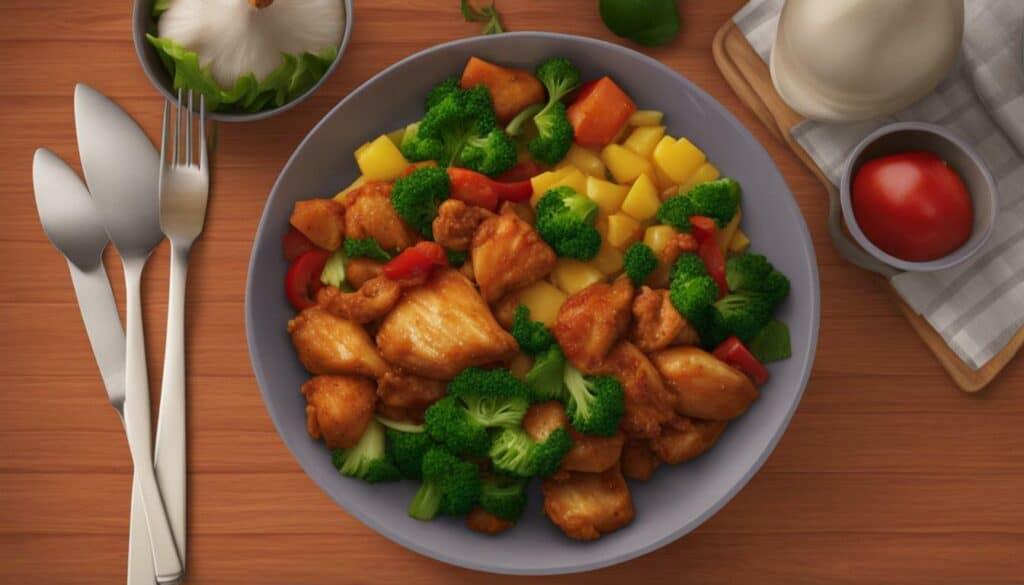
KFC also offers healthier alternatives to the Chicken Little. Grilled chicken options, for example, are lower in calories and fat. If you’re looking to reduce the calorie content of your Chicken Little, you can customize it by asking for less mayo or opting for whole wheat buns.
It’s worth noting that the Chicken Little can be part of a balanced diet when paired with healthier side options, such as a serving of vegetables or a salad. While it’s important to be mindful of the calorie and fat content in this snack, enjoying it in moderation can still fit into a healthy lifestyle.
Grilled Chicken vs. Fried Chicken
When it comes to choosing between grilled chicken and fried chicken, there are significant differences in their nutritional content. Grilled chicken is generally a healthier option as it has less fat and fewer calories compared to fried chicken.
Grilled chicken is cooked with direct heat on a grill, which typically takes more time. It has a smoky and intense flavor, is lower in fat, and provides important nutrients like iron and protein. On the other hand, fried chicken is covered in seasoned batter or flour and requires immersing the meat in hot oil. It has a less pronounced flavor, a crunchy texture, and is higher in calories and fat.
Grilled chicken can be a great substitute for fried chicken if you’re looking for a healthier alternative.
Other substitutes for chicken include nuts, beans, sprouts, tofu, ground turkey, lean beef, and pork. These options can provide similar flavors and textures without the high calorie and fat content typically found in chicken dishes.
In conclusion, understanding the nutritional content of Chicken Littles is essential for making informed food choices. While they can be enjoyed in moderation, it’s important to be aware of their calorie, fat, and sodium content. Consider healthier alternatives and customization options to reduce the calorie intake. Grilled chicken is a healthier choice compared to fried chicken, and there are various substitutes for chicken available for those looking to reduce their chicken consumption. By making conscious choices and incorporating a balanced diet, you can still enjoy tasty meals while taking care of your health.
The Importance of Portion Control
While Chicken Littles can be a satisfying meal option, it’s crucial to practice portion control for better calorie management. It’s easy to lose track of how much we eat, especially when indulging in our favorite fast food snacks. However, being mindful of portion sizes can help prevent overeating and ensure a healthier balance of calories.
When enjoying a Chicken Little, it’s important to remember that one sandwich is considered a serving size. If you’re ordering a meal, it’s essential to be aware of the additional calories from sides and drinks. Opting for smaller portion sizes, such as a single Chicken Little instead of a meal combo, can help manage calorie intake more effectively.
To visually understand the impact of portion control, take a look at the table below:
| Food Item | Calories |
|---|---|
| 1 Chicken Little | 310 |
| Small French Fries | 270 |
| Medium Soft Drink | 200 |
| Total Meal | 780 |
As shown in the table, a typical Chicken Little meal, including a sandwich, small fries, and a medium soft drink, can add up to a calorie intake of 780. By choosing to have just the sandwich and pairing it with a side of vegetables or a salad, you can significantly lower your calorie consumption while still enjoying the delicious taste of Chicken Littles.
By being mindful of portion sizes and making smarter choices when it comes to side dishes and drinks, you can incorporate Chicken Littles into a balanced diet. Remember, moderation is key, and by practicing portion control, you can indulge in your favorite fast food snacks while maintaining a healthier lifestyle.
Healthier Alternatives at KFC
If you’re looking for a healthier option at KFC, there are alternatives to Chicken Littles that can still satisfy your cravings. While the Chicken Little is a tasty snack, it’s important to be mindful of its calorie content and nutritional value. Luckily, KFC offers a variety of menu items that are lower in calories and fat, providing you with healthier choices.
One option is to opt for grilled chicken instead of the fried Chicken Littles. Grilled chicken is cooked with direct heat on a grill, resulting in a lower fat content and fewer calories. It has a smoky and intense flavor, making it a delicious alternative. Plus, grilled chicken is packed with important nutrients like iron and protein, making it a nutritious choice.
Another way to customize your meal is to request modifications to the Chicken Littles themselves. For example, you can ask for less mayo or opt for whole wheat buns, which can help reduce the overall calorie content. These small changes can make a big difference in the nutritional value of your meal.
Moreover, if you’re in the mood for something different, there are also substitutes for chicken that you can explore. Nuts, beans, sprouts, tofu, lean beef, pork, and ground turkey are all great alternatives that can be used in various recipes. These substitutes provide different flavors and textures, allowing you to enjoy a diverse range of meals while still watching your calorie intake.
Remember, it’s all about making informed choices and finding the options that work best for you and your dietary needs. By exploring healthier alternatives at KFC, customizing your Chicken Littles, or incorporating substitutes for chicken, you can enjoy a satisfying meal while prioritizing your health.
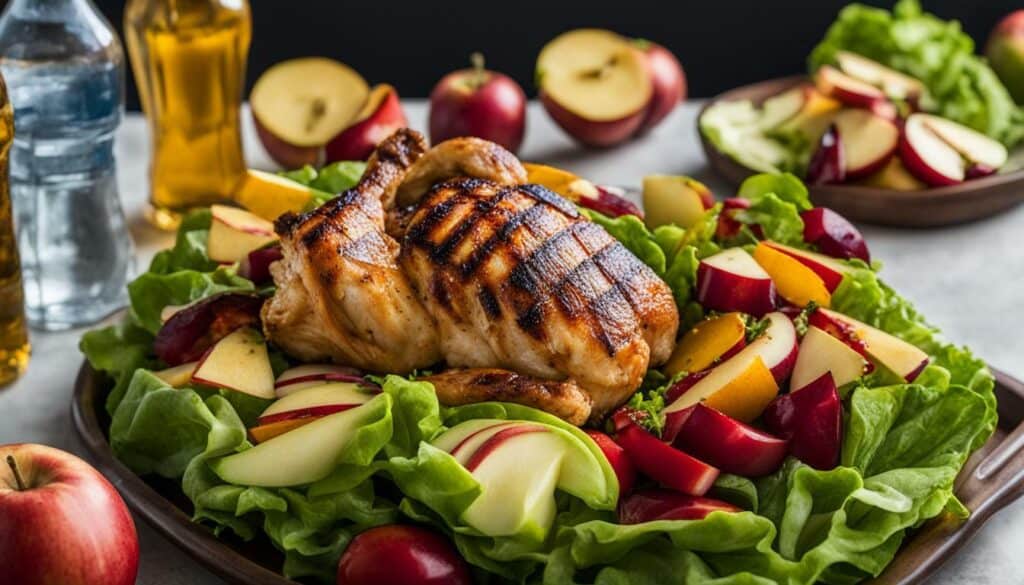
Table: Nutritional Information of Healthier Alternatives at KFC
| Menu Item | Calories | Total Fat | Sodium |
|---|---|---|---|
| Grilled Chicken Breast | 220 | 7g | 550mg |
| Grilled Chicken Thigh | 250 | 14g | 610mg |
| Fried Chicken Breast | 390 | 23g | 1,060mg |
| Fried Chicken Thigh | 420 | 29g | 1,120mg |
In summary, if you’re looking to make healthier choices at KFC, there are alternatives to Chicken Littles that can still satisfy your cravings. Opting for grilled chicken, customizing your Chicken Littles, or exploring substitutes for chicken are all great ways to enjoy a delicious meal while keeping an eye on your calorie intake. Remember to prioritize your health and make informed choices that work best for you.
Customizing Chicken Littles for a Lower Calorie Intake
Did you know that you can make small changes to your Chicken Littles order to decrease the calorie content? By customizing your Chicken Littles, you can still enjoy this tasty snack while keeping your calorie intake in check. Here are some tips to help you make healthier choices:
- Opt for whole wheat buns instead of regular buns to increase the fiber content of your Chicken Littles. This can help you feel fuller for longer and reduce the overall calorie intake.
- Requesting less mayo or skipping it altogether can significantly reduce the fat and calorie content of your Chicken Littles. You can still enjoy the delicious flavors of the sandwich without the extra calories from mayonnaise.
- Consider adding extra veggies to your Chicken Littles. By adding lettuce, tomatoes, or onions, you can enhance the nutritional value of your meal without adding many extra calories.
Customizing your Chicken Littles not only allows you to reduce the calorie content but also gives you the flexibility to tailor the sandwich to your taste preferences. Don’t be afraid to experiment with different modifications and find a combination that works best for you!
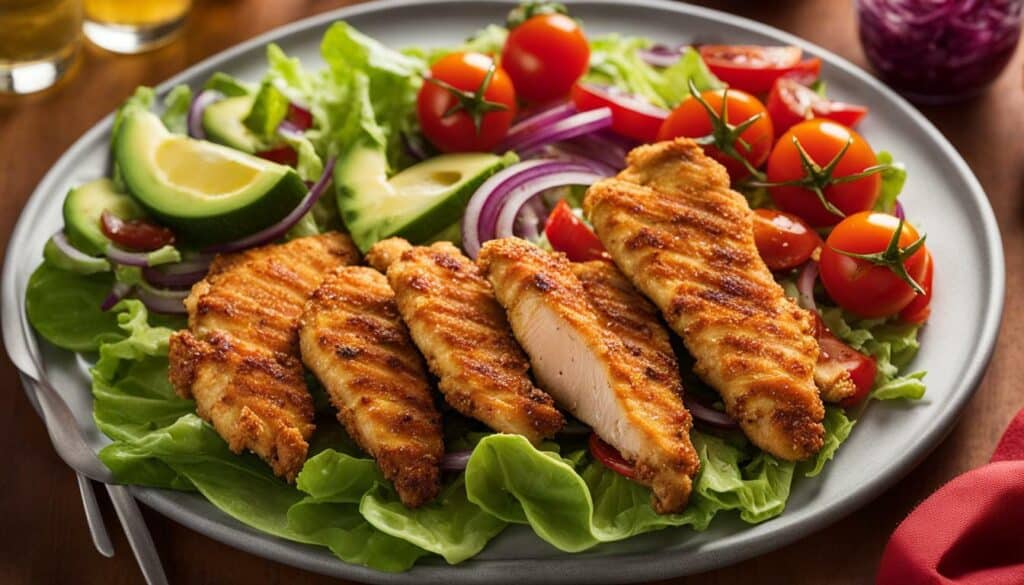
| Modification | Effect on Calories |
|---|---|
| Whole Wheat Bun | Reduces calorie intake by about 50 calories |
| No Mayo | Reduces calorie intake by about 70 calories |
| Extra Veggies | Increases nutritional value without adding many extra calories |
Remember, small changes can add up to make a big difference in your overall calorie intake. By customizing your Chicken Littles, you can enjoy this popular fast food snack while making healthier choices. Give it a try and see how delicious and satisfying a lower calorie Chicken Littles can be!
Considering Sodium Levels in Chicken Littles
While Chicken Littles are tasty, it’s essential to be mindful of their sodium content, especially if you have dietary restrictions. Each serving of these mini sandwiches contains approximately 670 milligrams of sodium, which is relatively high. For individuals who need to limit their sodium intake, such as those with high blood pressure or certain kidney conditions, it may be wise to exercise caution when consuming Chicken Littles.
Excess sodium intake can lead to water retention, increased blood pressure, and strain on the cardiovascular system. To maintain a healthy sodium balance, it is important to be aware of the sodium content in your diet. This includes monitoring your intake of high-sodium foods like Chicken Littles and making informed choices about portion sizes and overall sodium consumption.
If you are concerned about the sodium levels in Chicken Littles, there are alternative options available at KFC that are lower in sodium. You can opt for grilled chicken items, which typically have less sodium compared to their fried counterparts. Grilled chicken is cooked without the addition of breading or batter, resulting in a healthier and lower-sodium alternative. Pairing your Chicken Littles with a side of vegetables or a salad can also help balance out your meal and reduce sodium intake.
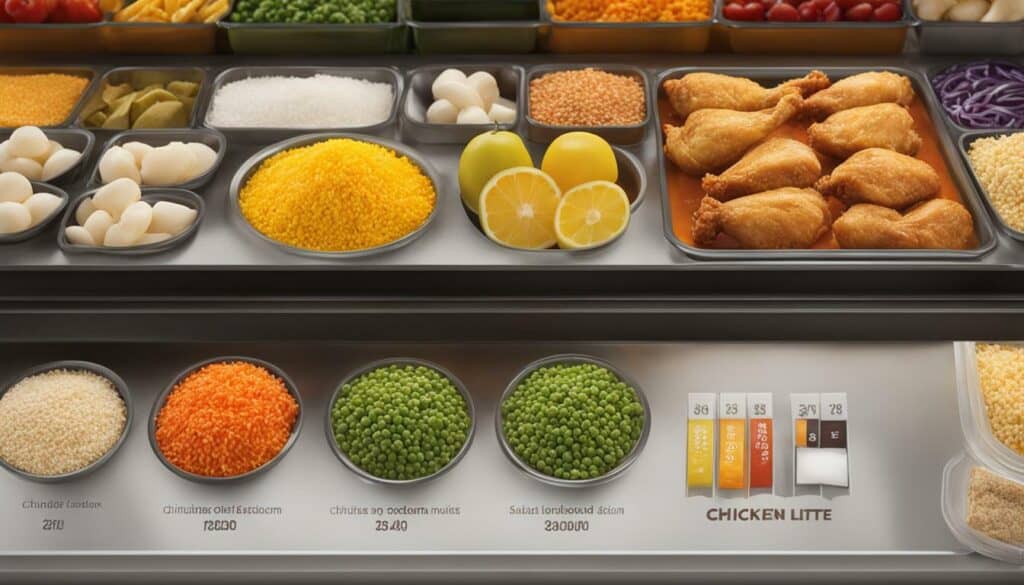
Being mindful of the sodium levels in Chicken Littles is important for maintaining a healthy diet. While they can be enjoyed as an occasional treat, it’s crucial to be aware of the potential impact on your sodium intake. By making informed choices and considering alternatives, you can enjoy a balanced and nutritious diet that suits your specific dietary needs.
Including Chicken Littles in a Balanced Diet
Enjoying Chicken Littles as part of a balanced diet is possible when you make smart choices and accompany them with nutritious sides. While Chicken Littles may not be the healthiest option on their own, they can be a satisfying treat when combined with other healthier foods.
When ordering Chicken Littles, consider pairing them with a side of vegetables or a salad. Adding a generous serving of fresh greens and colorful veggies will not only boost the nutritional value of your meal but also provide essential vitamins and minerals. This way, you can enjoy the indulgence of Chicken Littles while still nourishing your body with wholesome ingredients.
| Serving Size | Calories | Fat (g) | Carbohydrates (g) | Protein (g) | Sodium (mg) |
|---|---|---|---|---|---|
| 1 Chicken Little | 310 | 14 | 28 | 15 | 670 |
It’s also worth exploring healthier alternatives on the KFC menu. For example, grilled chicken options are lower in calories and fat compared to the fried counterparts. Grilled chicken provides a lean source of protein and can be a more nutritious choice for those watching their calorie intake. You can even customize your Chicken Littles by asking for less mayo or opting for whole wheat buns to reduce the calorie content.
Remember, moderation is key. While Chicken Littles shouldn’t be the foundation of your daily diet, they can be enjoyed as an occasional treat within a well-balanced eating plan. By making informed choices and balancing your meal with nutritious sides, you can savor the deliciousness of Chicken Littles while still prioritizing your health.
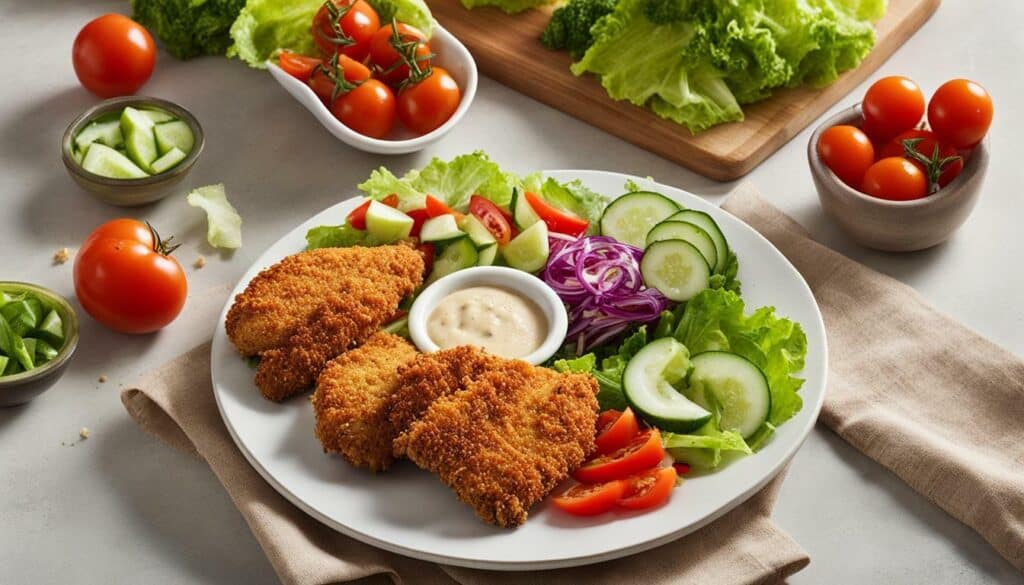
- 1 Chicken Little
- Side of mixed greens
- Steamed broccoli
- Slice of fresh pineapple
Grilled Chicken vs. Fried Chicken
When it comes to choosing between grilled chicken and fried chicken, the nutritional differences are worth considering. Grilled chicken is cooked with direct heat on a grill, resulting in a smoky and intense flavor. It takes more time to cook but is lower in fat and calories compared to fried chicken. On the other hand, fried chicken is covered in seasoned batter or flour and requires immersion in hot oil, resulting in a crunchy texture. However, it is higher in calories and fat.
Grilled chicken is a healthier choice due to its lower calorie and fat content. A serving of grilled chicken provides important nutrients like iron and protein. It is a versatile and tasty option that can be enjoyed in various dishes. In contrast, fried chicken, although delicious, is higher in calories and fat, making it a less ideal choice for those seeking a healthier option.
| Grilled Chicken | Fried Chicken |
|---|---|
| Lower in calories and fat | Higher in calories and fat |
| Smoky and intense flavor | Less pronounced flavor |
| Takes more time to cook | Requires immersion in hot oil |
| Provides important nutrients like iron and protein | Higher in calories and fat |
When making a choice between grilled chicken and fried chicken, it’s important to consider your health goals and dietary restrictions. Grilled chicken can be substituted for fried chicken in order to reduce calorie and fat intake without compromising on taste. Other substitutes for chicken include nuts, beans, sprouts, tofu, ground turkey, lean beef, and pork. These options provide alternative sources of protein while offering different flavors and textures.
In conclusion, grilled chicken is a healthier choice than fried chicken due to its lower calorie and fat content. It is a versatile and tasty option that can be enjoyed in many different dishes. So, the next time you’re craving chicken, consider opting for grilled chicken for a healthier alternative.

Grilled chicken not only offers a lower calorie and fat content but also provides important nutrients like iron and protein. Compared to fried chicken, grilled chicken is a healthier choice due to its cooking method and nutritional profile.
When chicken is grilled, it is cooked with direct heat on a grill, allowing excess fat to drip away. This results in lower fat content, making grilled chicken a better option for those looking to reduce their calorie intake. Grilled chicken also retains more of its natural juices, resulting in a moist and flavorful dish.
Aside from being lower in fat, grilled chicken is a good source of iron and protein. Iron is an essential mineral that helps transport oxygen throughout the body and supports energy production. Protein is important for building and repairing tissues, as well as supporting healthy immune function.
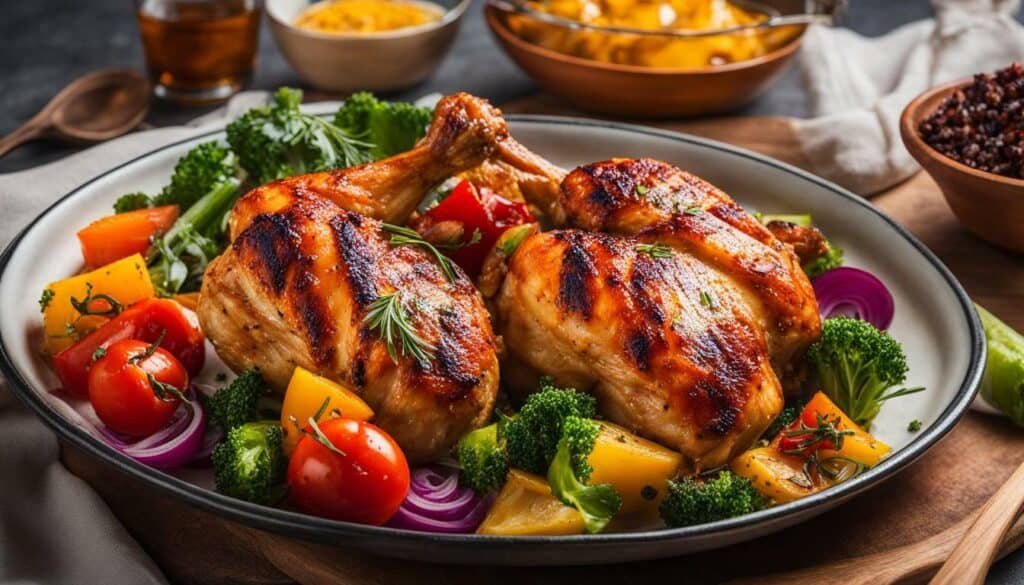
Including grilled chicken in your diet can be a delicious way to meet your nutritional needs while watching your calorie and fat intake. Whether enjoyed on its own or in a variety of dishes, grilled chicken offers a satisfying and nutritious option for meals and snacks.
Substitutes for Chicken
If you’re looking to cut back on chicken, there are several tasty alternatives to consider. Whether you’re seeking healthier options or simply looking to diversify your protein sources, these substitutes can add variety to your meals. Here are some delicious alternatives to chicken:
- Nuts: Almonds, cashews, and peanuts are packed with protein and healthy fats. They can be roasted, sprinkled on salads, or ground into nut butter for a satisfying and nutrient-rich addition to your diet.
- Beans: Black beans, kidney beans, and chickpeas are excellent plant-based protein sources. They can be used in soups, stews, or mashed, forming the base for delicious veggie burgers.
- Sprouts: Alfalfa sprouts, bean sprouts, and broccoli sprouts are nutrient-dense and add a refreshing crunch to sandwiches, wraps, and salads.
- Tofu: Made from soybeans, tofu is a versatile ingredient that can be grilled, stir-fried, or baked. It absorbs flavors well and is an excellent substitute for chicken in Asian-inspired dishes.
- Ground Turkey: With a similar texture to ground chicken, turkey is a leaner option that works well in recipes calling for ground meat, such as meatballs, tacos, and chili.
- Lean Beef and Pork: If you still crave the richness and flavor of meat, lean cuts of beef or pork can be enjoyed in moderation. Opt for grass-fed or organic varieties for a healthier choice.
By incorporating these alternatives into your meals, you can explore new flavors, increase your protein intake, and reduce your reliance on chicken. Remember, it’s essential to find a balance that suits your dietary needs and preferences.
| Chicken Substitute | Protein Content (per 100g) | Calories (per 100g) |
|---|---|---|
| Nuts (Almonds) | 21g | 579 |
| Beans (Black Beans) | 21g | 132 |
| Sprouts (Bean Sprouts) | 2.6g | 31 |
| Tofu | 8g | 144 |
| Ground Turkey | 21g | 149 |
| Lean Beef | 26g | 250 |
| Lean Pork | 25g | 143 |
Conclusion
In conclusion, being aware of the calories and nutritional content of Chicken Littles allows us to make healthier choices without compromising on taste. The Chicken Little from KFC is a mini sandwich that contains approximately 310 calories, 14 grams of fat, 28 grams of carbohydrates, and 15 grams of protein. While it can serve as a reasonable choice for a quick meal or snack, it is essential to consider the calorie intake, especially if consumed regularly.
KFC offers healthier alternatives to the Chicken Little, such as grilled chicken options that are lower in calories and fat. Grilled chicken is generally healthier than fried chicken, as it has less fat and fewer calories. Grilling involves cooking the chicken with direct heat on a grill, resulting in a smoky and intense flavor. It takes more time to cook but provides important nutrients like iron and protein. On the other hand, fried chicken is covered in seasoned batter or flour and requires immersing the meat in hot oil. It has a less pronounced flavor, a crunchy texture, and is higher in calories and fat.
For those who still prefer the taste of the Chicken Little, it is possible to customize it to reduce the calorie content. By asking for less mayo or opting for whole wheat buns, you can lower the overall calorie intake. However, the Chicken Little may not be suitable for people on a low-sodium diet due to its high sodium content, approximately 670 milligrams per serving.
Including Chicken Littles in a balanced diet is possible when consumed in moderation and paired with healthier side options. Adding a side of vegetables or a salad can help balance out the overall meal and ensure a more complete nutritional profile. Additionally, there are various substitutes for chicken for those looking to reduce their chicken consumption, such as nuts, beans, sprouts, tofu, ground turkey, lean beef, and pork. These alternatives provide versatility and allow for a range of delicious and nutritious meal options.
FAQ
Q: How many calories are in a Chicken Little from KFC?
A: A Chicken Little from KFC contains approximately 310 calories.
Q: What is the nutritional content of a Chicken Little?
A: A Chicken Little contains 14 grams of fat, 28 grams of carbohydrates, and 15 grams of protein.
Q: Is the Chicken Little high in sodium?
A: Yes, the Chicken Little is relatively high in sodium, with approximately 670 milligrams per serving.
Q: Are there healthier alternatives to the Chicken Little at KFC?
A: Yes, KFC offers healthier alternatives such as grilled chicken options that are lower in calories and fat.
Q: Can I customize the Chicken Little to reduce the calorie content?
A: Yes, you can customize the Chicken Little by asking for less mayo or opting for whole wheat buns.
Q: Is the Chicken Little suitable for people on a low-sodium diet?
A: The Chicken Little may not be suitable for people on a low-sodium diet due to its high sodium content.
Q: Can I include Chicken Littles in a balanced diet?
A: Yes, Chicken Littles can be included in a balanced diet when consumed in moderation and paired with a side of vegetables or a salad.
Q: Is grilled chicken healthier than fried chicken?
A: Yes, grilled chicken is generally healthier than fried chicken as it has less fat and fewer calories.
Q: What are the benefits of grilled chicken?
A: Grilled chicken has a lower calorie and fat content, provides important nutrients like iron and protein, and has a smoky and intense flavor.
Q: Are there substitutes for chicken?
A: Yes, there are substitutes for chicken such as nuts, beans, sprouts, tofu, ground turkey, lean beef, and pork.
How Many Calories are in Honey Chicken Compared to Chicken Littles?
When it comes to counting calories in honey chicken recipe versus chicken littles, there is a noticeable difference. Honey chicken typically contains more calories due to the added sweetness from honey. On the other hand, chicken littles are usually breaded and fried, which can increase their calorie content. So, if you are mindful of calorie intake, it’s important to consider these factors when making your choice.





Leave a Reply